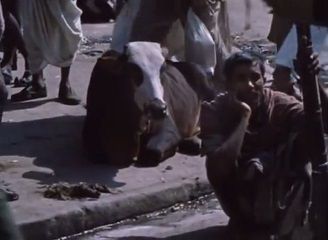Calcutta is a difficult city.

In February 1968, Louis Malle and a two-man crew -- cinematographer Étienne Becker and sound man Jean-Claude Laureux, both of whom later worked on Place de la République -- spent three weeks on the streets of Calcutta soaking in the sights and sounds of the bustling Bengali city. Produced at the same time as Malle's sprawling documentary miniseries Phantom India -- also released in 1969 -- theoretically, Calcutta should be easier to digest since it's about a quarter of Phantom's length, but it packs a hell of a lot of misery into its 99-minute running time.
By far, the majority of Calcutta is spent observing the city's poor, opening with shots of men bathing themselves in the Hooghly River and closing with images of a slum overflowing with cow dung. In between, Malle captures brief glimpses of where and how the other half lives -- at a race track in sight of a memorial to Queen Victoria, a golf club, a bourgeois wedding -- but his sympathies lie more with those crowded onto trains or buses and working in factories or building sites. Religious ceremonies and processions also catch his camera's eye, as do political demonstrations, one purposefully nonviolent, another that meets with a harsh crackdown. Throughout, Malle keeps his narration to a minimum and keeps himself off-camera entirely, but his destitute subjects frequently look straight into the lens, daring it to keep filming them -- and, by extension, daring the viewer to keep watching. It's not easy, but it is worthwhile.